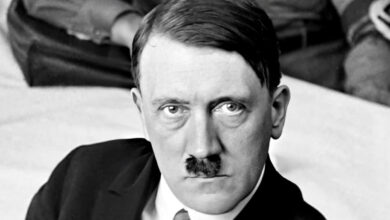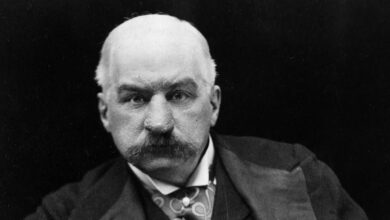Podcast: Play in new window | Download
Subscribe: Spotify | Amazon Music | Youtube Music | RSS
Jacques-Yves Cousteau was born on 11 June 1910 in Saint-André-de-Cubzac, Gironde, which is not too far from Bordeaux in South-Western France.
He initially attended preparatory school at the exclusive Collège Stanislas in Paris before entering France’s naval academy from which he graduated as a gunnery officer. He had intended to become a navy pilot, but his ambitions were thwarted by a car accident in which he broke both of his arms. Fortunately, as well as aviation, Jacques had another passion, which was the ocean and whilst serving aboard the battleship Condorcet, he began to conduct his first underwater experiments.
On 12 July 1937, Jacques married Simone Melchior and together they had two sons, Jean-Michel who was born in 1938, and Philippe who came along in 1940. After the outbreak of the Second World War and the signing of the armistice between France and Germany in 1940, the Cousteau family took refuge in Megève in the French Alps near Mont Blanc. Whilst there, he met and began working with Marcel Ichac who also shared a desire to bring knowledge of unknown and wondrous places to the attention of the general public. For Marcel, this was about the highest peaks, but for Jacques, it was all about what lay beneath the surface of the oceans. Working together they produced the first underwater film in 1942 which was shot at a depth of 18 metres without the aid of breathing apparatus. The film won first prize at the Congress of Documentary Film the following year. Also in 1943, after working on designs for an aqualung with a French engineer called Émile Gagnan, Cousteau used an early prototype to make a film called Shipwrecks. Throughout the rest of the 1940s, he made improvements to the design of the aqualung until it became recognisable as the type of SCUBA gear used by divers to this day.
As well as his work on underwater films, Cousteau was also actively involved in the French resistance and received several military decorations, including the Legion of Honour.
After the war, Cousteau showed the Shipwrecks film to Admiral Lemonnier who gave him and his fellow producer Philippe Tailliez the responsibility for setting up the Underwater Research Group within the French Navy in Toulon. This eventually became the Underwater Studies and Research Group and then the Undersea Interventions Command.
He co-wrote a book with Frédéric Dumas about his work called Le Monde de Silence (The Silent World), which was published in 1953 and which contained details of the daring rescue of Professor Jacques Piccard and his bathyscaphe during a 1949 expedition to Dakar, the same year that Cousteau left the French Navy. In 1950 he leased an ex British minesweeper for the symbolic cost of one franc per year and refitted it as an oceanographic research ship which he named Calypso.
In 1956, The Silent World was adapted into a documentary that won the Palme d’Or at 1956’s Cannes International Film Festival and an Academy Award in 1957, which was the first of three such awards Cousteau would receive for his films.
Also in 1957, Jacques Cousteau was appointed as the Director of the Oceanographic Museum in Monaco and also headed up a program in the 1960s called the Conshelf Saturation Dive Program which performed research into the effects of working underwater for extended periods and at various depths. It was during this period that he also co-invented with Jean Mollard an experimental underwater vehicle which he called the diving saucer which could reach depths of up to 350 metres. Later versions would reach a depth of 500 metres.
To continue to fund his work, Cousteau started many enterprises in various fields, including marketing, engineering, manufacturing and research. These all came together to become the Cousteau Group in 1973 and he also founded the non-profit Cousteau Society, which was dedicated to marine conservation.
However, Jacques Cousteau is probably most famous for his work on television and produced and starred in many shows, including The Undersea World of Jacques Cousteau which ran between 1968 and 1976. He also produced several documentaries with his son Philippe who was to be the successor to his work when it was time to hand over the reins. These plans would not come to pass though, as on 28 June 1979, Philippe was killed when the PBY Catalina he was flying in crashed in the Tagus River near Lisbon, Portugal. Although deeply affected by his son’s death, he began collaborating with his other son Jean-Michel and they worked tirelessly together for 14 years.
He continued to make films during the 1980s and also contributed to the work of others and was a regular on the animal reality show called Those Amazing Animals, and he was awarded the U.S. Presidential Medal of Freedom in 1985.
Following his wife Simone’s death from cancer on 2 December 1990, in June the following year, Cousteau married Francine Triplet with whom he already had two children, born during his first marriage, called Diane and Pierre-Yves and after Jacques’ death Francine became head of both the Cousteau Foundation and the Cousteau Society and in that capacity, she continues her husband’s work. Jacques Cousteau died following a heart attack on 25 June 1997 in Paris, just after his 87th birthday and is buried in the family vault at his birthplace, Saint-André-de-Cubzac. His legacy includes 120 television documentaries, over 50 books and a foundation with over 300,000 members aimed at environmental protection.
Podcast: Play in new window | Download
Subscribe: Spotify | Amazon Music | Youtube Music | RSS




